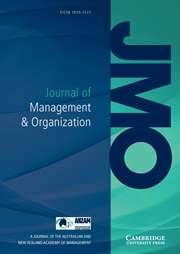Article contents
Vertical and lateral dynamics of middle managers’ strategizing for institutional complexity
Published online by Cambridge University Press: 23 September 2024
Abstract
Research suggests that institutional complexity is of strategic importance and recent calls have been made to investigate organizational strategizing in such a situation of multiple institutional logics. We therefore investigate middle managers’ strategizing for institutional complexity. In doing so, we follow theoretical suggestions of a renewed practice-based view on strategizing as a broad social accomplishment beyond top management activities. Based on a qualitative field study in a company under influence of substantive financial reform, findings show that middle managers re-strategize institutional complexity at the vertical interstices of top management strategies and the distributed agency of their followers. Furthermore, the study highlights the character and effects of lateral dynamics of middle managers’ competing strategizing. We explain how these vertical and lateral dynamics provide insight into strategizing for institutional complexity as a distributed, situated, and emergent social accomplishment. Such strategizing practices have unintended organizational consequences beyond both top and middle management control.
Keywords
Information
- Type
- Research Article
- Information
- Copyright
- © The Author(s), 2024. Published by Cambridge University Press in association with Australian and New Zealand Academy of Management.
References
- 3
- Cited by

